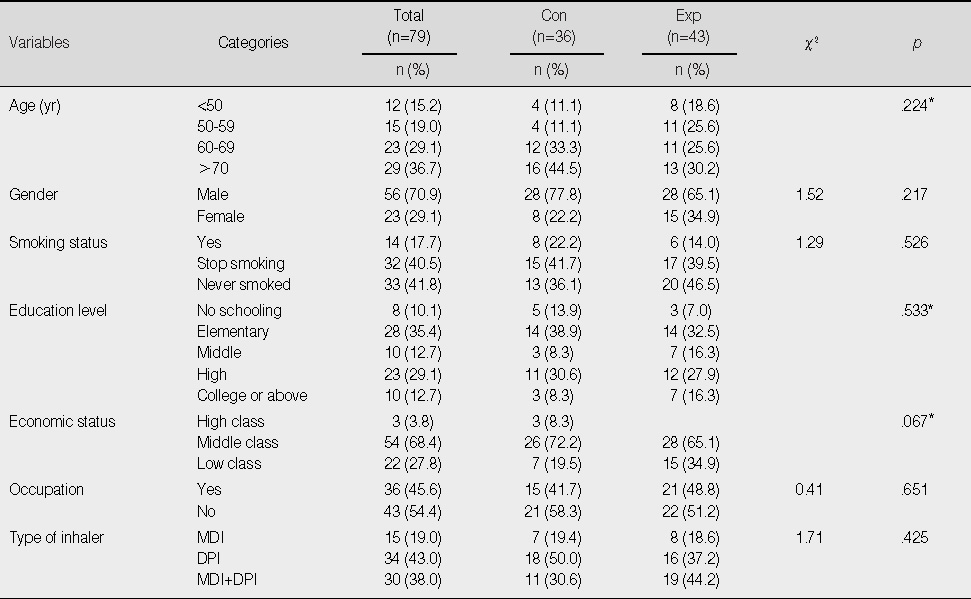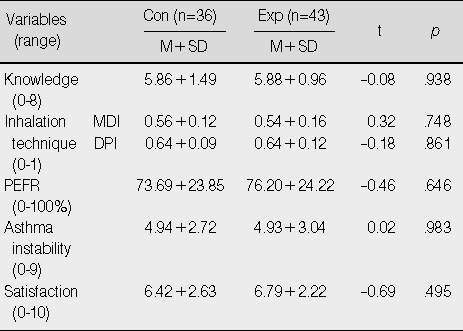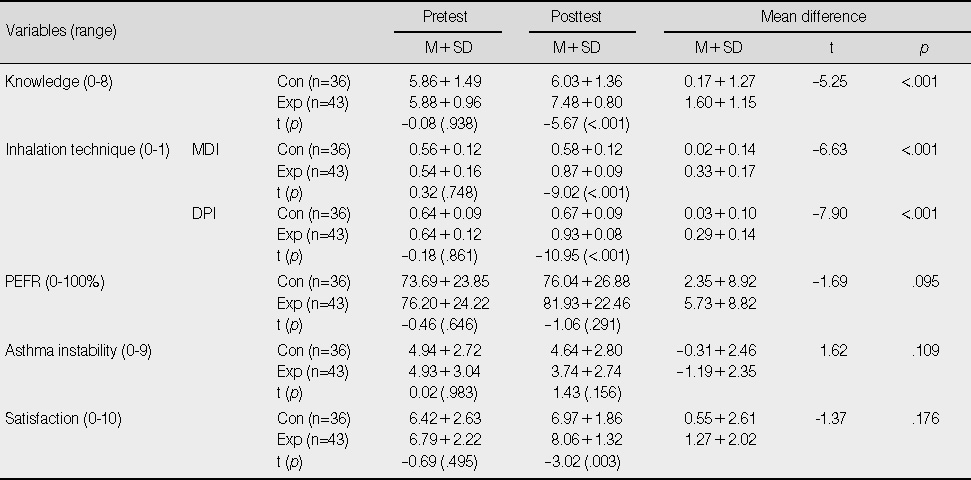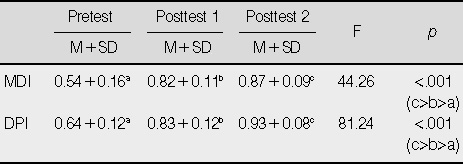Articles
- Page Path
- HOME > J Korean Acad Nurs > Volume 40(2); 2010 > Article
-
Original Article
- Evaluation of an Education Program for Patients with Asthma who use Inhalers
- Jong Kyung Lee, Young Hee Yang
-
Journal of Korean Academy of Nursing 2010;40(2):202-212.
DOI: https://doi.org/10.4040/jkan.2010.40.2.202
Published online: April 30, 2010
1Associate Professor, Department of Nursing, Dankook University, Cheonan, Korea.
2Professor, Department of Nursing, Dankook University, Cheonan, Korea.
- Address reprint requests to: Lee, Jong Kyung. Department of Nursing, Dankook University, San 29 Anseo-dong, Cheonan 330-714, Korea. Tel: 82-41-550-3883, Fax: 82-41-550-3888, kyunglee@dankook.ac.kr
Copyright © 2010 Korean Society of Nursing Science
Abstract
-
Purpose
- This study was done to evaluate the effectiveness of an education program for patients with asthma who use inhalers.
-
Methods
- The research design for this study was a non-equivalent control group quasi-experimental study. Participants in this study were 36 patients for the control group, and 43 patients for the experimental group. The experimental group participated in the education program. The control group received the usual care. Data were collected before and 1 month and 2 months after the program finished and were analyzed using the SPSS 12.0 program.
-
Results
- The experimental group had significantly higher scores of knowledge of inhalers, and inhalation technique compared to the control group. However, no significant differences were found between two groups for PEFR, asthma instability, and satisfaction with inhalers.
-
Conclusion
- According to the results, the education program was effective in improving knowledge of inhalers, and inhalation technique. Therefore, it is recommended that this education program be used in clinical practice as an effective nursing intervention for patients with asthma on inhalers.
This work was supported by the Korea Research Foundation Grant funded by the Korean Government (MOEHRD, Basic Research Promotion Fund) (KRF-2008-314-E00262).
- 1. Basheti IA, Armour CL, Bosnic-Anticevich SZ, Reddel HK. Evaluation of a novel educational strategy, including inhaler-based reminder labels, to improve asthma inhaler technique. Patient Education and Counseling. 2008;72:26–33.ArticlePubMed
- 2. Basheti IA, Reddel HK, Armour CL, Bosnic-Anticevich SZ. Counseling about turbuhaler technique: Needs assessment and effective strategies for community Pharmacists. Respiratory Care. 2005;50:617–623.
- 3. Cohen J. Statistical power analysis for the behavioral science. 1988;2nd ed. Hillsdale, NJ, Lawrence Erbaum Associates Publishers.
- 4. Epstein S, Maidenberg A, Hallett D, Khan K, Chapman KR. Patient handling of a dry powder inhaler in clinical practice. Chest. 2001;120:1480–1484.ArticlePubMed
- 5. Fink JB, Rubin BK. Problems with inhaler use: A call for improved clinician and patient education. Respiratory Care. 2005;50:1360–1375.PubMed
- 6. Giraud V, Roche N. Misuse of corticosteroid metered-dose inhaler is associated with decreased asthma stability. European Respiratory Journal. 2002;19:246–251.ArticlePubMed
- 7. Hilton S. An audit of inhaler technique among asthma patients of 34 general practitioners. British Journal of General Practice. 1990;40:505–506.
- 8. Johnson DH, Robart P. Inhaler technique of outpatients in the home. Respiratory Care. 2000;45:1182–1187.PubMed
- 9. Khassawneh BY, Al-Ali MK, Alzoubi KH, Batarseh MZ, Al-Safi SA, Sharara AM, et al. Handling of inhaler devices in actual pulmonary practice: Metered-dose inhaler versus dry power inhalers. Respiratory Care. 2008;53:324–328.PubMed
- 10. Kim SG, Jang AS, Kim YK, Lee S, Seo JP, Yang SW, et al. The effect of patient education on correct use of metered dose inhalers in patients with asthma. Journal of Asthma, Allergy and Clinical Immunology. 2000;20:695–701.
- 11. Kwak JH, Kwon DY, Han SB, Jeon YJ. Validity of peak expiratory flow for assessing reversible airflow obstruction. Tuberculosis and Respiratory Diseases. 2000;48:522–529.Article
- 12. Kwon MG, Jung HM, Jin YD. The approaches to enhance the efficiency of patient education for chronic respiratory diseases. Journal of Korean Society of Health-System Pharmacists. 2005;22:19–22.
- 13. Lee MB. Clinical outcome of educational program using self-monitoring of peak expiratory flow rate for asthma patients. 1999;Seoul, Sookmyung Women's University. Unpublished master's thesis.
- 14. Luk HH, Chan PM, Lam FF, Lau KY, Chiu SY, Fung YL, et al. Teaching chronic obstructive airway disease patients using a metered-dose inhaler. Chinese Medical Journal. 2006;119:1669–1672.ArticlePubMed
- 15. Markson LE, Vollmer WM, Fitterman L, O'connor E, Narayanan S, Berger M, et al. Insight into patient dissatisfaction with asthma treatment. Archives Internal Medicine. 2001;161:379–384.Article
- 16. Mogil J. Many asthma patients experience persistent symptoms despite appropriate clinical and guideline-based treatment with inhaled corticosteroids. Journal of American Academy of Nurse Practitioners. 2007;19:459–470.Article
- 17. Molimard M, Raherison C, Lignot S, Depont F, Abouelfath A, Moore N. Assessment of handling of inhaler devices in real life: An observational study in 3,811 patients in primary care. Journal of Aerosol Medicine. 2003;16:249–254.ArticlePubMed
- 18. National Health Insurance Corporation. Analysis of patients with environmental disease in 2007. 2009;01 19 Retrieved July 20, 2009. from http://www.nhic.or.kr/cms/board/board/Board.jsp?act=VIEW&communityKey=B0070&boardId=489.
- 19. National Heart, Lung, and Blood Institute. National Asthma Education and Prevention Program Expert Panel Report III: Guidelines for the diagnosis and management of asthma. 2007;08 28 Retrieved July 8, 2008. from http://www.nhlbi.nih.gov/guidelines/asthma/asthgdln.pdf.
- 20. Nunn AJ, Gregg I. New regression equations for predicting peak expiratory flow in adults. British Medical Journal. 1989;298(6680):1068–1070.ArticlePubMedPMC
- 21. Park SY, Cho YS, Ji HS, Lee JC, Kim YY, Lee TH, et al. Evaluation of the inhalation performance in patients with asthma. Journal of Asthma, Allergy and Clinical Immunology. 2003;23:781–787.
- 22. Prabhakaran L, Lim G, Abisheganaden J, Chee CB, Choo YM. Impact of an asthma education programme on patients' knowledge, inhaler technique and compliance to treatment. Singapore Medical Journal. 2006;47:225–231.PubMed
- 23. Savage I, Goodyer L. Providing information on metered dose inhaler technique: Is multimedia as effective as print? Family Practice. 2003;20:552–557.ArticlePubMed
- 24. Scarpaci LT, Tsoukleris MG, Mcpherson ML. Assessment of hospice nurses' technique in the use of inhalers and nebulizers. Journal of Palliative Medicine. 2007;10:665–676.ArticlePubMed
- 25. Son HY, Kim MG, Kwon MG, Jung HM, Jin YD. The assessment of the levels of patient satisfaction and the strategy for improvement of education program for patients with respiratory disease in Paik Hospital. Journal of Korean Society of Health-System Pharmacists. 2007;24:124–130.
- 26. Song WS, Mullon J, Regan NA, Roth BJ. Instruction of hospitalized patients by respiratory therapists on metered-dose inhaler use leads to decrease in patient errors. Respiratory Care. 2005;50:1040–1045.PubMed
- 27. Yu SK, Park SI, Park SY, Park JK, Kim SE, Kim JY, et al. The effect of repeated education using a computerized scoring system for the proper use of inhalation medicine. Tuberculosis and Respiratory Diseases. 2007;63:491–496.Article
REFERENCES
Figure & Data
REFERENCES
Citations

- Effects of a tailored inhaler use education program for chronic obstructive pulmonary disease patients
Yu Mi Kim, Mi Yu, Hye Ri Moon, Sun Young Ju, Gyeong Ae Lee, Min Jin Kim
Patient Education and Counseling.2020; 103(4): 717. CrossRef - Development and Effects of Health Education Program using Flipped Learning for Allergic Rhinitis Patients
Young Sil Lee, Young Eun
Journal of Korean Academic Society of Nursing Education.2019; 25(2): 173. CrossRef - The Effects of Smartphone-based Nebulizer Therapy Education on Parents' Knowledge and Confidence of Performance in Caring for Children with Respiratory Disease
Jung Min Lee, Shin-Jeong Kim, Hae Young Min
Journal of Pediatric Nursing.2017; 36: 13. CrossRef - Interventions to improve inhaler technique for people with asthma
Rebecca Fortescue, Kayleigh M Kew, Alexander G Mathioudakis
Cochrane Database of Systematic Reviews.2017;[Epub] CrossRef - Effects of Educational Interventions for Chronic Airway Disease on Primary Care
Jung Yeon Lee, Kwang Ha Yoo, Deog Kyeom Kim, Sang-Ha Kim, Tae-Eun Kim, Tae-Hyung Kim, Chin Kook Rhee, Yong Bum Park, Hyoung Kyu Yoon, Ho-Kee Yum
Journal of Korean Medical Science.2016; 31(7): 1069. CrossRef - Potential benefit of repeated MDI inhalation technique counselling for patients with asthma
Marwa O Elgendy, Mohamed E Abdelrahim, Randa Salah Eldin
European Journal of Hospital Pharmacy.2015; 22(6): 318. CrossRef - The Efficacy of Immediate Diet for Reducing Local Adverse Events of Inhaled Corticosteroid: A Pilot Study
Myoung Kyu Lee, Won Yeon Lee, Suk Joong Yong, Kye Chul Shin, Chong Whan Kim, Ji-Ho Lee, Saehyun Jung, Ye-Ryung Jung, Hyun Sik Kim, Tae-Sun Yu, Sang-Ha Kim
Tuberculosis and Respiratory Diseases.2012; 73(2): 93. CrossRef - Effects of an Education Program on Knowledge about Environmental Health and Allergy Symptoms among Elementary School Students
Hae-Kyung Jo, Myung-Hwa Kang, Joon-Soo Park, Mi-Ryeong Song
Journal of Korean Academy of Fundamentals of Nursing.2012; 19(1): 57. CrossRef - Home-based educational interventions for children with asthma
Emma J Welsh, Maryam Hasan, Patricia Li
Cochrane Database of Systematic Reviews.2011;[Epub] CrossRef - The Evaluation of an Education Program for Using an Inhaler Devices in Childhood Asthma
Eun-Jeong Choi, Hyun-Jin Yun, Hye-Sung An, Ju-Suk Lee, Jin-A Jung
Pediatric Allergy and Respiratory Disease.2011; 21(2): 108. CrossRef - Skills in Handling Turbuhaler, Diskus, and Pressurized Metered-Dose Inhaler in Korean Asthmatic Patients
Sang Min Lee, Yoon-Seok Chang, Cheol-Woo Kim, Tae-Bum Kim, Sang-Heon Kim, Yong-Eun Kwon, Jong-Myung Lee, Soo-Keol Lee, Jae-Won Jeong, Jung-Won Park, Sang-Heon Cho, Hee-Bom Moon, Young-Koo Jee
Allergy, Asthma and Immunology Research.2011; 3(1): 46. CrossRef

Figure 1
Homogeneity Test of General Characteristics between Control and Experimental Groups
* Fisher's exact test.
Con=control group; Exp=experimental group; MDI=metered dose inhaler; DPI=dry powder inhaler.
Homogeneity Test of Dependent Variables between Two Groups
Con=control group; Exp=experimental group; MDI=metered dose inhaler; DPI=dry powder inhaler; PEFR=peak expiratory flow rate.
Mean Differences in Dependent Variables between Two Groups
Con=control group; Exp=experimental group; MDI=metered dose inhaler; DPI=dry powder inhaler; PEFR=peak expiratory flow rate.
Change in Inhaler Technique Score over the Time for the Experimental Group (N=43)
MDI=metered dose inhaler; DPI=dry powder inhaler.
* Fisher's exact test. Con=control group; Exp=experimental group; MDI=metered dose inhaler; DPI=dry powder inhaler.
Con=control group; Exp=experimental group; MDI=metered dose inhaler; DPI=dry powder inhaler; PEFR=peak expiratory flow rate.
Con=control group; Exp=experimental group; MDI=metered dose inhaler; DPI=dry powder inhaler; PEFR=peak expiratory flow rate.
MDI=metered dose inhaler; DPI=dry powder inhaler.
 KSNS
KSNS
 E-SUBMISSION
E-SUBMISSION





 Cite
Cite

